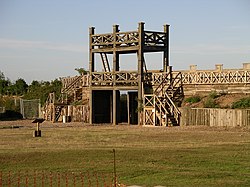Lunt Roman Fort
| Lunt Roman Fort | |
|
Warwickshire | |
|---|---|
 The reconstructed main gatehouse at Lunt | |
| Type: | Roman fort |
| Location | |
| Village: | Baginton |
| History | |
| Information | |
| Condition: | Partially reconstructed |
The Lunt Roman Fort is the archaeological site of a Roman fort in the village of Baginton outside Coventry, Warwickshire. The name given to the fort by the Romans is unknown.
The fort has now been fully excavated and partially reconstructed; the wooden gateway was rebuilt by the Royal Engineers using the same tools and techniques that the military engineers of the Roman Army would have used.[1]
History
Nothing is known of the fort from the historical record; the site was discovered when large quantities of Roman pottery were found in the 1930s. Archaeological excavation started during the 1960s has revealed an intriguing site with three distinct periods of occupation namely a sequence of Roman military camps on the site.
The camp was occupied first by a legion, then, in the second phase by a cohort which reduced the size of the fort and demolished a number of buildings to construct a gyrus. This second phase lasted around twenty years until the fort was decommissioned. Over a century later it was recommissioned as a temporary fortification.
Location
There is a large steep bank just beyond the northern boundary of the fort, which descends to the River Sowe. From the fort at the top of the bank there are good views of the landscape north for two or three miles and buildings of Coventry city centre can be seen about four miles away.
Historical interpretation
Lunt fort was an active site during periods of unrest in Roman Britain.[2] The fort was built around AD 60 to act as a supply depot and headquarters for the Roman Army during the final campaign against Boudica.[3]
Notable features
The north, south and west sides followed the usual pattern for a Roman camp of straight ditches and ramparts. However, on the east side the defences bulge out and within the bulge a circular structure 35 yards in diameter had been created. The sand and gravel subsoil had been dug out to a depth of 24 inches to 35 inches and the area surrounded with a timber stockade.[4]
This ring, the only known "gyrus" in the Roman Empire, may have been used for training horses.[3] The gyrus was added to the fort during its second period of occupation and its construction caused significant disruption to the fort. Having the gyrus within the fort affects not just the wall which curves to accommodate the structure deviating from the Roman playing card shape pattern but also the layout of the fort which is significantly different from the standard layout. This makes the fort unique not just in Britain but also in the Roman Empire.


Reconstruction and modern use of the site
From the 1960s, Brian Hobley, keeper of field archaeology at the Coventry Museum, commenced a long term project to combine excavation with a study of the methods by which Roman camps were built.[5]
During the 1970s some features of the fort were reconstructed upon the original foundations; these are a section of the wall, a gateway modelled on images of Trajan's column, one of the three granaries and the gyrus.
The fort is open for public, school visits and organised tours and has hosted many holiday excavation trips.[6]
Finds
In 2001 a team of Canadian students unearthed a fragment of Roman Samian pottery and a Nero's head coin dating from 65 AD.[6] Other finds have included a ring etched with a palm leaf. This type of design symbolized victory and was worn by successful gladiators.[7]
Evidence of Saxon settlement was unearthed in 2001[6] and finds evidencing mediæval occupation include large post holes and a post-Roman ditch filled with pottery fragments.[6]
Gallery
- Modern reconstructions
-
The main gate to the fort - outer aspect
-
A granary
Outside links
| ("Wikimedia Commons" has material about Lunt Roman Fort) |
References
- ↑ Noonan, Damien TOP 10 WEBSITES FOR... THE ROMANS IN BRITAIN The Daily Telegraph, 26 July 2008
- ↑ Brian Hobbs, The Final Excavation Report, 1978
- ↑ 3.0 3.1 Coventry Telegraph, Romans in action at Lunt Fort, 3 July 2009
- ↑ The Times, First-century 'rodeo' in Roman fort 12 December 1970
- ↑ The Times, Army helps to rebuild Roman fort 23 October 1970
- ↑ 6.0 6.1 6.2 6.3 Goulden, Barbara Dig reveals life after the Romans Coventry Telegraph, 20 August 2001
- ↑ Goulden, Barbara. Ancient find at the Lunt hints of Roman games, Coventry Telegraph, 3 May 2007
- Brian Hobley, BA. FSA. M.St. (Oxon) Excavator (1969) 'A Neronian-Vespasianic Military Site at The Lunt Baginton, Warwickshire' (Trans. B'ham & Wars.Archaeological Society.Vol.83 (1969)
- 'Excavations at The Lunt Roman Military Site Baginton, Warwickshire' 1968-71.' ( Trans. B'ham & Wars.Archaeological Society. Vol.85 (1972)
- 'The Lunt Roman Fort & Training School for Roman Cavalry, Baginton, Warwickshire. Excavations 1972-73' Trans. B'ham & Wars. Archaeological Society Vol.86


